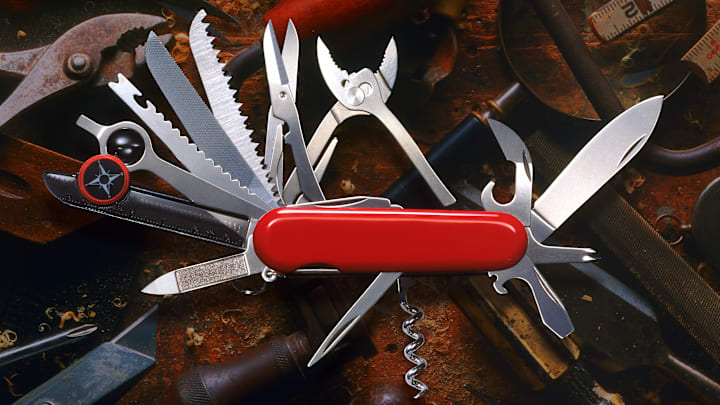Anyone with a deep love for gadgets is familiar with a Swiss Army knife. The multipurpose pocket tool appears able to tackle any task, from sawing through rope to uncorking a bottle of champagne to trimming your eyebrows. It even became a metaphor for a person or device that can seemingly do it all.
But is it really from Switzerland? And was it ever really deployed in the Swiss Army?
The Origins of the Swiss Army Knife
In the 1800s, the Swiss Army had a problem. The military observed a need for a small, portable tool that could serve a number of different purposes in the field, from maintaining a rifle to opening rations. Carrying a cumbersome tool set was impractical. Ideally, they needed an all-in-one tool that would be unobtrusive. But no one in Switzerland had the resources to craft one.
The idea itself wasn’t new. Multipurpose tools had been in existence for decades and even received a mention in Herman Melville’s 1851 novel Moby-Dick, which described a knife that doubled as a corkscrew and tweezers. Later, in 1880, a man named John Holler marketed an outlandish knife design with over 100 uses, with arms that extended out to deploy cigar cutters or mini-shovels.
Holler’s knife, which was made in Germany, was never intended to be useful, exactly. It was meant to grab attention and solidify his company’s reputation for fine cutlery. According to Smithsonian, elaborate knives like these were more about demonstrating culters’ skill. They would go on “tour,” appearing at festivals, fairs, and other public gatherings—but deploying them on the field was impossible.
Aside from practicality, outsourcing the knife to another country rubbed some Swiss the wrong way. Swiss knifemaker Karl Elsener believed they should keep their knife business domestic. Elsener manufactured surgical knives at his factory in Ibach-Schwyz; crafting a multi-pronged tool was well within his capability. His multipurpose knife was delivered to the Swiss army in 1891.
There was room for improvement. “It had a large blade, a can opener, a screwdriver and a reamer all on one side,” Elsener’s great-grandson, Carl, told The New York Times in 1991. “On the other side was nothing. It was very strong but a little heavy so my great-grandfather decided to make a more elegant knife for officers which had a corkscrew and a second blade.” This second, improved knife was given to the Swiss Army in 1897.
But there was still the problem of meeting production demands. Elsener got around those limitations by forming a group, the Association of Swiss Master Cutlers, that permitted other knifemakers to share in filling military orders. Elsener and another company, Wenger, would later split production duties for many years.
The Swiss Army Moniker
Elsener’s company was dubbed Victorinox—a blend of his mother Victoria’s name and inox, another name for the stainless steel used to make the tool. But Elsener didn’t call it a “Swiss Army Knife”—he dubbed it the Original Swiss Officer’s and Sports Knife.
The knife came by its more familiar name leading up to World War II, when American soldiers who couldn’t pronounce German took to calling it a “Swiss Army Knife.” The Oxford English Dictionary dates the first printed use of the term in English in 1935.
Like a lot of wartime tools, foods, and accessories, returning veterans brought plenty of Swiss Army knives back with them. They subsequently wound up in utility drawers and in the pockets of Boy Scouts. The knife was also fairly easily identifiable by the symbol on its body—a white cross on a red shield. Civilian models sported a red handle so they would be more visible in the snow.
While the knives may seem like a gimmick, they’ve proven surprisingly useful. In 1990, a physician named Charles Plotkin was on a plane when a passenger began choking. Plotkin used another passenger’s Swiss Army knife to cut a hole in the man’s neck, permitting air passage. (Plotkin should have been carrying a specialized Swiss Army Knife that came with a tracheotomy blade.)
Victorinox estimates roughly 500 million Swiss Army knives have been manufactured since 1891. That includes non-terrestrial sales: NASA has issued Swiss Army knives to astronauts since the 1970s. You never know when you might need a fish scaler, even in outer space.
Read More About Tool Names:
